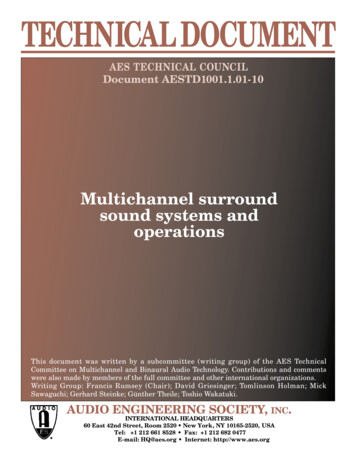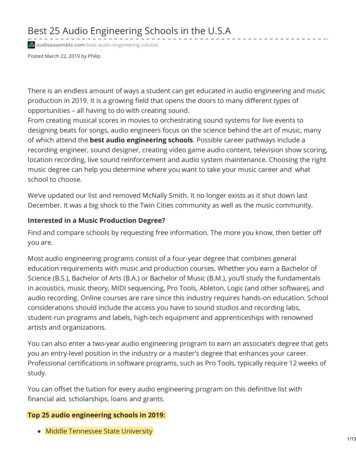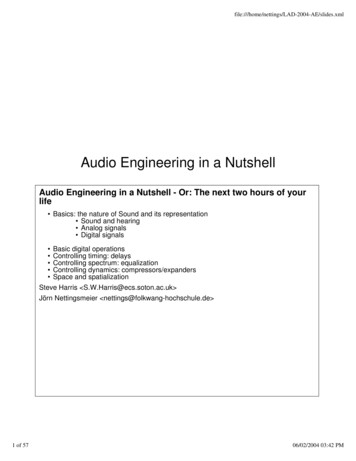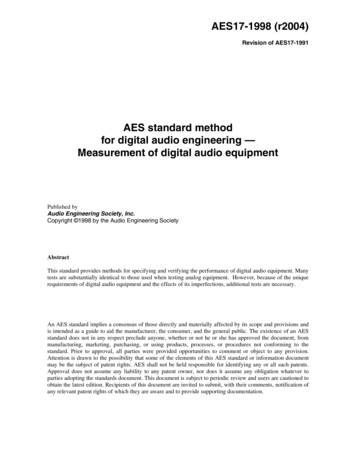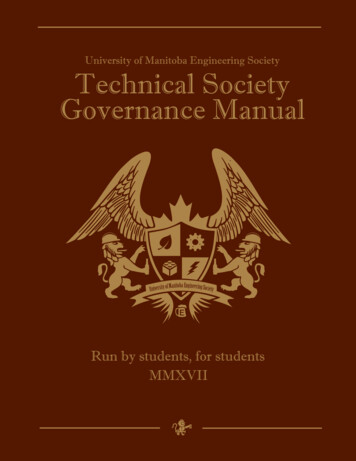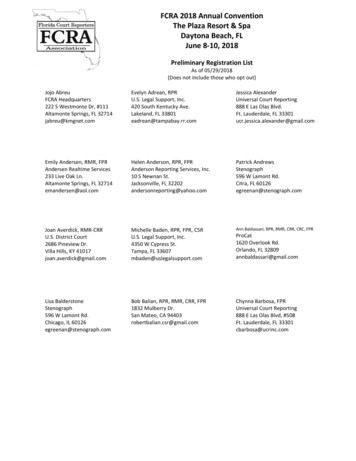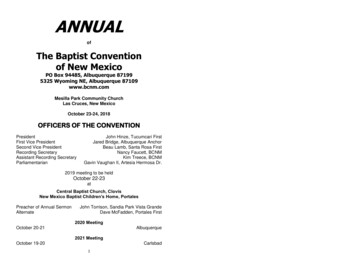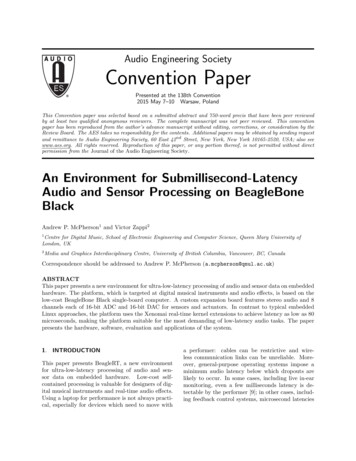
Transcription
Audio Engineering SocietyConvention PaperPresented at the 138th Convention2015 May 7–10 Warsaw, PolandThis Convention paper was selected based on a submitted abstract and 750-word precis that have been peer reviewedby at least two qualified anonymous reviewers. The complete manuscript was not peer reviewed. This conventionpaper has been reproduced from the author’s advance manuscript without editing, corrections, or consideration by theReview Board. The AES takes no responsibility for the contents. Additional papers may be obtained by sending requestand remittance to Audio Engineering Society, 60 East 42nd Street, New York, New York 10165-2520, USA; also seewww.aes.org. All rights reserved. Reproduction of this paper, or any portion thereof, is not permitted without directpermission from the Journal of the Audio Engineering Society.An Environment for Submillisecond-LatencyAudio and Sensor Processing on BeagleBoneBlackAndrew P. McPherson1 and Victor Zappi21Centre for Digital Music, School of Electronic Engineering and Computer Science, Queen Mary University ofLondon, UK2Media and Graphics Interdisciplinary Centre, University of British Columbia, Vancouver, BC, CanadaCorrespondence should be addressed to Andrew P. McPherson (a.mcpherson@qmul.ac.uk)ABSTRACTThis paper presents a new environment for ultra-low-latency processing of audio and sensor data on embeddedhardware. The platform, which is targeted at digital musical instruments and audio effects, is based on thelow-cost BeagleBone Black single-board computer. A custom expansion board features stereo audio and 8channels each of 16-bit ADC and 16-bit DAC for sensors and actuators. In contrast to typical embeddedLinux approaches, the platform uses the Xenomai real-time kernel extensions to achieve latency as low as 80microseconds, making the platform suitable for the most demanding of low-latency audio tasks. The paperpresents the hardware, software, evaluation and applications of the system.1.INTRODUCTIONThis paper presents BeagleRT, a new environmentfor ultra-low-latency processing of audio and sensor data on embedded hardware. Low-cost selfcontained processing is valuable for designers of digital musical instruments and real-time audio effects.Using a laptop for performance is not always practical, especially for devices which need to move witha performer: cables can be restrictive and wireless communication links can be unreliable. Moreover, general-purpose operating systems impose aminimum audio latency below which dropouts arelikely to occur. In some cases, including live in-earmonitoring, even a few milliseconds latency is detectable by the performer [9]; in other cases, including feedback control systems, microsecond latencies
McPherson AND ZappiSubmillisecond-Latency Audio and Sensor Processingare needed for mathematical stability [3].Real-time audio systems can be divided into hardand soft real-time categories according to whetherthe timing is guaranteed by design. Audio ongeneral-purpose computers is soft real-time: audiocalculations usually hit their deadlines, but systemload can cause buffer underruns and, therefore, gapsin the output. Hard real-time, which guarantees thatevery deadline will be met, is achievable with singlefunction microcontroller and DSP systems. The system in this paper achieves hard real-time performance using a commodity single-board ARM computer and a custom software environment based onthe Xenomai Linux kernel extensions.11.1. Latency of Audio SystemsAudio latency on general-purpose operating systemscan vary wildly; in 2010, Wang et al. [14] found results ranging from just over 3ms on Linux and MacOS X to over 70ms on certain configurations of Windows. Mobile and embedded platforms are similarlyvariable, with latency as low as 2.5ms for certainsettings of the Linux ALSA sound architecture onBeagleBone Black [12] to hundreds of millisecondson some versions of the Android OS (as of 2012) [8].Latency comes from several sources: buffering bythe OS and drivers, group delay of interpolation anddecimation filters within sigma-delta audio converters [13], and group delay introduced by the end-useraudio processing itself (especially where block-basedcalculations are used). Of these, buffering is the factor most affected by the design of the operating system. Minimum latency measurements can mask performance limitations: while simple audio code mightbe able to run with small buffers, more demandingcode might require a large buffer size and hence along latency to avoid frequent buffer underruns.1.2. Embedded Musical Instrument PlatformsMany platforms for creating self-contained musicalinstruments have been developed in the past fewyears. These can be divided into high-performance1 In this audio context, the term hard real-time is usednot in the strictest sense that a single missed deadline is acatastrophic event certified never to occur, but in the loosersense that deadline performance depends only on the contentof the audio code and not on any external system factors, andthat dropouts should be essentially zero with suitable code.The term firm real-time is also sometimes used here.microcontrollers and embedded computers runninggeneral-purpose operating systems. Recent microcontroller instrument platforms include CUI32Stem[11], the OWL effects pedal [15], the SPINE toolkit[7] and the Mozzi2 audio library for Arduino. Othercommonly used boards include mbed (mbed.org),Teensy 3.1 (pjrc.com), STM32F4Discovery (st.com)and Arduino Due (arduino.cc).Other instrument platforms are based on embeddedLinux/Unix computers. Mobile phones and tabletsare widely used for audio. Satellite CCRMA [1, 2] isa popular and well-supported platform using Raspberry Pi (or BeagleBoard XM) connected to an Arduino microcontroller; sound is generated by audioprograms such as Pd and ChucK. Sonic Pi3 is a livecoding environment for Raspberry Pi intended forclassroom use. The original BeagleBone running Pdhas also been used for real-time audio [10].In general, microcontroller platforms offer easy connections to hardware sensors and predictable timing, but have limited computing power. Embeddedcomputers benefit from the ability to use familiarsoftware tools (Pd, SuperCollider, ChucK, etc.) andfrom the resources of a general-purpose OS, including file I/O and networking. On the other hand,general-purpose operating systems are optimised tobalance many simultaneous processes, and may notguarantee audio performance under load.Since many mobile devices and embedded computers do not provide easy hardware connections forsensors, Arduino and similar microcontrollers are often connected by a serial port. This creates a bottleneck which limits sensor bandwidth (typically to115.2kbps or less). As a result, sensor data is oftensampled infrequently or at low bit resolution. Serialor USB timing uncertainties also contribute to jitterbetween sensor and audio samples. Each of theseeffects can reduce the sensitivity of the instrument.1.3. GoalsBeagleRT aims to combine the best aspects ofembedded Linux systems and dedicated microcontrollers for real-time audio. The specific goals are:2 http://sensorium.github.io/Mozzi/3 http://sonic-pi.netAES 138th Convention, Warsaw, Poland, 2015 May 7–10Page 2 of 7
McPherson AND ZappiSubmillisecond-Latency Audio and Sensor Processing1. Simultaneous stereo audio and multichannelsensor data capture2. Ultra-low latency, less than 1ms round trip3. High sensor bandwidth with no bottleneck between sensor and audio processing4. Jitter-free synchronisation of audio and sensordata5. Robust performance under load; no buffer underruns due to unrelated processes6. Lightweight C-based API7. Self-contained platform suitable for inclusion inside a digital musical instrument2. HARDWAREBeagleRT is based on the BeagleBone Black4 singleboard computer, which contains a 1GHz ARMCortex-A8 processor with NEON vector floatingpoint unit, 512MB of RAM and 4GB of onboardstorage. The BeagleBone also includes two Programmable Realtime Units (PRUs), 200MHz microcontrollers with access to the same memory and peripherals as the CPU. The PRUs are specificallydesigned for real-time, timing-sensitive tasks, withmost instructions executing in a single 5ns cycle.Figure 1 shows a custom hardware expansion board(“BeagleRT cape”) which provides stereo audio input and output, plus 8 channels each of 16-bit ADCand 16-bit DAC for sensors and actuators. Theboard also contains onboard stereo 1.1W speakeramplifiers for making self-contained instruments.2.1. AudioThe audio portion of the cape derives from theschematic of the open-source BeagleBone AudioCape, revision B5 . It uses a TLV320AIC3104 codecfrom Texas Instruments; the codec is capable ofup to 96kHz operation though BeagleRT uses it in44.1kHz mode. The codec includes an onboard headphone amplifier as well as a line output, both of4 http://beagleboard.org/black5 http://elinux.org/CircuitCo:AudioCape RevBFig. 1: BeagleRT cape: expansion board containing stereo audio in/out, 8-channel ADC and DAC,stereo speaker amplifiers. BeagleBone Black seenunderneath at left.which are accessible on the cape. Like nearly allaudio codecs, the TLV320AIC3104 uses sigma-deltamodulation, and the internal decimation and interpolation filters introduce 17 and 21 samples of latency, respectively (together, approximately 860µsat 44.1kHz).2.2. Sensor/Actuator ADC and DACSensor and actuator signals are provided by anAD7699 8-channel ADC and an AD5668 8-channelDAC from Analog Devices. Both ADC and DAC(hereafter termed the sensor ADC and DAC ) areDC-coupled; the ADC inputs are buffered with opamps, and the DAC outputs can drive up to 30mA,making these signals suitable for a variety of sensorapplications.The ADC uses an SAR-type converter which addsonly 2µs sampling latency. Typical settling time forthe DAC output is 2.5µs. Therefore, applications requiring near-zero latency are better suited to theseparts than the audio codec. However, any antialiasing filters must be implemented externally in analog.The sensor ADC and DAC share a 24MHz SPI bus;the bus speed sets the upper limit on sample rate. Intotal, BeagleRT achieves 176 ksps input and output(2.8 Mbps each direction) when synchronised to theaudio clock, with selectable configurations of 2, 4 or8 channels (see Section 3.1). If the ADC and DACare free running without synchronisation to audio,roughly 50% higher sample rate can be achieved.AES 138th Convention, Warsaw, Poland, 2015 May 7–10Page 3 of 7
McPherson AND Zappi3.Submillisecond-Latency Audio and Sensor ProcessingSOFTWAREBeagleRT is based on Linux with the Xenomai6 realtime kernel extensions. In 2010, Brown and Martin[4] found that Xenomai is the best-performing of thehard real-time Linux environments. On BeagleRT,audio processing runs as a Xenomai task with higherpriority than the kernel itself, ensuring audio is unaffected by Linux system load.Running audio at higher priority than the Linux kernel means that kernel hardware drivers cannot beused. We developed a custom driver for the audiocodec and the sensor ADC/DAC. The driver uses theBeagleBone PRU to effectively act as a sophisticatedDMA (Direct Memory Access) controller. The PRUshuttles data between the hardware and a memorybuffer; the Xenomai audio task then processes datafrom this buffer (Figure 2).BeagleRTAudio TaskBeagleRTSystem sesPRULinuxKernel(non-realtime)I2S AudioSPI ADC/DACNetwork,Network,USB,USB,etc.etc.Fig. 2: Operation of the BeagleRT software. Theaudio task runs under Xenomai, bypassing the kernelusing a custom PRU-based hardware driver.3.1. Sample Rates and FormatsAudio is sampled at 44.1kHz. The PRU also samples each of the 8 sensor ADC and DAC channels at22.05kHz, a much higher sample rate than typicallyfound in digital musical instruments. This allowscapturing subtle details like audio-rate vibrations ordetailed temporal profiles within sensor signals. Italso means that sensor data is immediately availableto the programmer, with no need to request and waitfor readings.Buffer sizes as small as 2 audio samples ( 1 sensor ADC/DAC sample) are supported. This compares favourably with audio buffer sizes of 32 samples or more on typical general-purpose operating6 http://xenomai.orgsystems [14]. Alternative sensor ADC and DACformats are available: instead of sampling 8 channels at 22.05kHz each, 4 channels can be sampled at44.1kHz, or 2 channels at 88.2kHz.3.2. APIBeagleRT is written in C , but the API for working with audio and sensor data is standard C. Fullcode is available through the Sound Software project[5].7 In an arrangement similar to common audio plug-in APIs, the programmer writes a callbackfunction which is called by the BeagleRT system every time a buffer of new samples is required. Thecallback function provides input and output buffersfor both audio and sensor data. For convenience,all data is in float format, normalised -1 to 1 foraudio, 0 to 1 for sensor ADC/DAC data.In addition to the audio callback, the API providesinitialisation and cleanup functions in which the programmer can allocate and free resources. A simple wrapper is provided to create and manage otherXenomai real-time tasks; the programmer can specify the priority of these tasks, which will always behigher than the Linux OS but lower than the audiorendering task. For example, large block-based calculations might be delegated to a lower-priority taskif the audio buffer size is very small, since the entirecalculation might not fit in one audio period.Finally, all of the resources of the standard LinuxOS are available at normal (non-realtime) priorities.Xenomai will transparently switch a task from realtime to non-realtime mode whenever an OS call ismade. BeagleRT thus offers the performance advantages of a dedicated microcontroller system with thebroader feature set of a general-purpose OS.4.PERFORMANCE AND APPLICATIONS4.1. LatencyThe theoretical round-trip latency of either audioor sensor data is given by twice the buffer length.For example, a simple passthrough program runningwith a buffer size of 8 audio samples at 44.1kHz willproduce 16 samples (0.36ms) of latency from inputto output. The TLV320AIC3104 audio codec adds afurther 17 samples latency at the input for the decimation filter and 21 samples at the output for the7 AES 138th Convention, Warsaw, Poland, 2015 May 7–10Page 4 of 7
McPherson AND ZappiBufferSize643216842Submillisecond-Latency Audio and Sensor ProcessingLatency: Audio In to Audio OutPredictedPredicted(buffer only) ( codec) 09ms0.95ms1.02msTable 1: Audio latency performance of BeagleRT environment under different buffer sizes, fs 44.1kHz. Predicted values given without and with860µs group delay internal to codec.interpolation filter (0.86ms in total). The conversionlatency for the sensor/actuator ADC and DAC arenegligible, about 5µs total.Latency: Sensor ADC ch. 0 to DAC ch. 0Buffer Size ble 2: Sensor ADC/DAC latency performance ofBeagleRT environment under different buffer sizes,fs 22.05kHz.later than channel 0. The lowest latency is obtainedby passing ADC channel 7 (the last to be sampled)to DAC channel 0 (the first to be sampled), withthis arrangement measuring 80 23µs.Actual latency was measured with an oscilloscopeand signal generator. In each test, a 50Hz squarewave was applied to the input, and the software wasconfigured to pass input to output unchanged. Thelatency was calculated by measuring the differencein time between edges of the input and output. Fortests with the sensor ADC, the edge of the squarewave could drift with respect to the ADC samplingperiod; this artifact is a form of aliasing from the unfiltered test signal. Latency measurements involvingthis ADC would drift by up to one sampling period(46µs). The mean value is reported for these tests.All of these results compare favourably with 3ms latency using the Linux ALSA drivers on the samehardware [12]. 1ms audio latency meets even themost demanding of live monitoring applications [9].Results for audio input/output are reported in Table 1, and sensor results are reported in Table 2.In both cases, the results conform closely to predictions. Minimum audio latency is just over 1ms,mostly due to the sigma-delta codec, while the minimum sensor latency is 120 23µs.Table 3: Measured latency performance of BeagleRT environment for signals going from sensorADC to audio output and from audio input to sensorDAC, fs,aud 44.1kHz, fs,sens 22.05kHz.A hybrid scenario was tested passing audio input tosensor/actuator DAC and, conversely, sensor ADCto audio output (Table 3). The measured latencyis approximately halfway between audio and sensorscenarios, with the audio DAC showing greater internal latency than the audio ADC. This result conforms to expectations from the datasheet.Informal testing suggests that audio performance isindependent of system load, though the reverse isnot true: smaller buffer sizes and more complexaudio calculations reduce the computing resourcesavailable to the Linux OS. This is expected from theXenomai implementation. BeagleRT is intended forsingle-purpose embedded devices, so a penalty onnon-realtime system tasks is generally acceptable.Finally, the effect of different sensor and actuatorchannels was tested (Table 4). These channels aresampled in a round-robin fashion via the SPI bus,so channel 7 will be sampled almost 7/8 of a periodLatency: ADC to Audio Out; Audio In to DACAudio Buffer ADC to Audio Audio to 0.53ms4.2. PerformanceAs an approximate metric for overall audio performance, a wavetable oscillator bank was implementedusing ARM NEON vector floating point instruc-AES 138th Convention, Warsaw, Poland, 2015 May 7–10Page 5 of 7
McPherson AND ZappiSubmillisecond-Latency Audio and Sensor ProcessingLatency: Effect of ADC/DAC ChannelsADC Channel DAC Channel Measured070.158ms040.144ms000.120ms400.097ms70 0.080msTable 4: Latency performance of BeagleRT environment for different combinations of sensor ADCand DAC channels, 1 sensor frame per buffer, fs 22.05kHz.tions.8 Table 5 shows the results wih a 1024-pointwavetable (wavetable size did not have a significantimpact on performance). Performance is similar forbuffers of 8 samples or larger, plateauing at 740 oscillators above 32 samples. The smallest buffer sizeof 2 samples shows a performance reduction of about25%, due to the overhead of frequent task switching.Uniquely, the behaviour of the D-Box can be subverted by rewiring analog circuits on an internalbreadboard. Unlike modular synthesisers, the instrument’s behaviour is determined by feedbackloops between software and circuits, creating unusual results when changed. The feedback loops,which are implemented using the sensor ADC andDAC, are only possible because of BeagleRT’s lowand predictable latency.BeagleRT can also be used for active feedback control applications; [6] uses it to apply feedback andfeedforward control to a string instrument bridge.Using the sensor ADC and DAC on the same channels, active feedback control up to 3.1kHz bandwidthcan be obtained with 45 phase margin.By comparison, earlier testing using ALSA and Ccode with compiler optimisation showed a maximumof 74 oscillators with a buffer size of 512 samples.9NEON Oscillator Bank PerformanceAudio Buffer Size Max # Oscillators3274016724870046482552Table 5: Maximum number of oscillators before underruns occurred using a 1024-point wavetable oscillator bank.4.3. ApplicationsBeagleRT forms the basis for the D-Box hackablemusical instrument [16] (Figure 3). The D-Box isa self-contained instrument: a 15cm wooden cubecontaining two capacitive touch sensors, a pressure sensor,
Audio Engineering Society Convention Paper Presented at the 138th Convention 2015 May 7{10 Warsaw, Poland . University of British Columbia, Vancouver, BC, Canada . audio task runs under Xenomai, bypas
